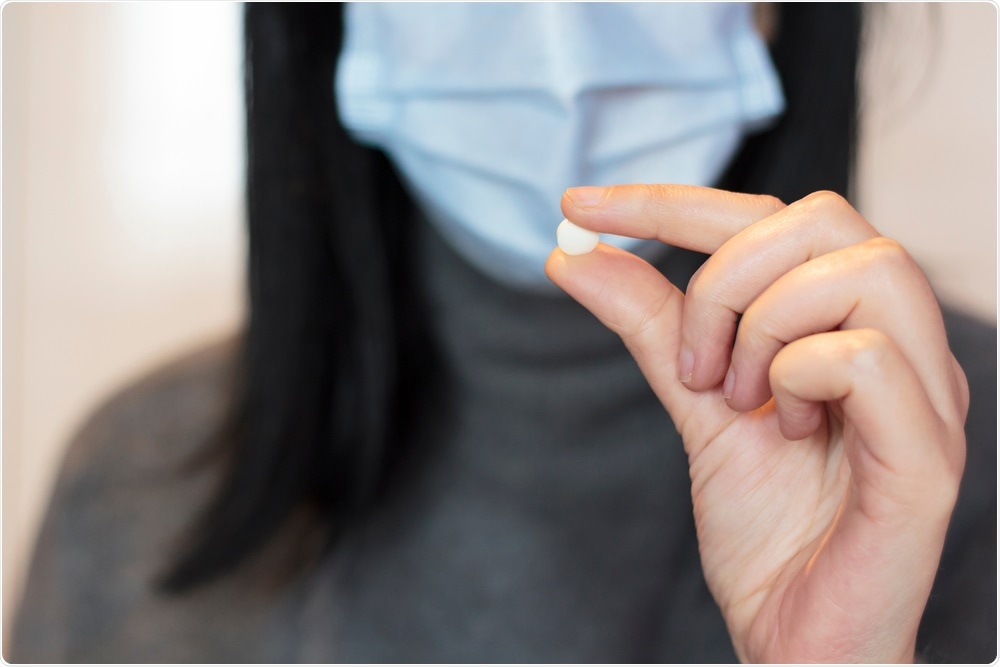Phase I trial investigates using antiparasitic nitazoxanide for treatment of COVID-19
During the coronavirus disease 2019 (COVID-19) pandemic, there have been many instances of drugs being repurposed for use against the disease. These include trialed and approved drugs such as remdesivir and tocilizumab, to potentially dangerous and ineffective drugs such as ivermectin.
 Study: An open label, adaptive, phase 1 trial of high-dose oral nitazoxanide in healthy volunteers: an antiviral candidate for SARS-CoV-2. Image Credit: rfranca / Shutterstock.com
Study: An open label, adaptive, phase 1 trial of high-dose oral nitazoxanide in healthy volunteers: an antiviral candidate for SARS-CoV-2. Image Credit: rfranca / Shutterstock.com
This repurposing of drugs is primarily due to the limited therapeutic that are currently available for treatment against the novel severe acute respiratory syndrome coronavirus 2 (SARS-CoV-2). To date, the most common drugs that are used to treat COVID-19 include steroids and interleukin-6 (IL-6) blockers. In a recent study published on the preprint server medRxiv*, researchers from the University of Liverpool investigate the possibility of using the thiazolide antiparasitic nitazoxanide for the treatment of COVID-19.
What is nitazoxanide?
Nitazoxanide is effective in the treatment of cryptosporidiosis and giardiasis and has also demonstrated effectiveness against anaerobic bacteria, protozoa, and several viruses. Some trials have shown antiviral properties of nitazoxanide; however, this activity was observed at small doses that could increase the risk of SARS-CoV-2 in developing resistance against this drug.
Nitazoxanide is effective against the influenza virus due to its impact on post-translational modification and maturation of hemagglutinin. A recent study reported a similar mechanism involving the SARS-CoV-2 spike protein, which is an essential component of SARS-CoV-2 for its entry into host cells. To this end, researchers hypothesize that nitazoxanide may help to stimulate the immune system for a more rigorous response against COVID-19.
Several similar drugs have been reported to block the SARS-CoV-2 spike protein-mediated syncytia formation. This process involves the formation of a mass of fused cells with several nuclei that can cause extensive lung damage. As nitazoxanide is already approved by the United States Food and Drug Administration (FDA), along with the fact that it is cheap and available globally, this drug shows great promise as a potential treatment approach to COVID-19.
About the study
As the current study discusses results from a Phase I trial, only healthy volunteers between the ages of 18 and 75 were included. Moreover, no pregnant or breastfeeding individuals, nor any individuals who were currently taking any medications or suffering from any clinically significant allergy, were included in the current study.
Taken together, this study included 14 individuals who received 1500 mg of nitazoxanide twice a day with food for one week. The researchers evaluated the safety of the volunteers by assessing the presence of any side effects, as well as their tolerability of the drug. The researchers were also interested in determining the optimal dose and best schedule to administer nitazoxanide.
On days 1 and 5, volunteers were dosed in an inpatient unit; however, for the remainder of the study, the participants could medicate themselves at home. All volunteers were administered polymerase chain reaction (PCR) tests to exclude the possibility of COVID-19. The authors monitored the volunteers’ general physical health, serum chemistry, and hematology at the screening phase two days before the drug was administered, the first day of the study, as well as 120 hours post-dose. Urinalysis was also performed at more frequent intervals.
Study findings
Unfortunately, due to suspected QTcB prolongation, which is a drug-induced heart problem, in one patient, dosing was suspended early for 4 volunteers. Eight of the other volunteers completed six full days of dosing, with two completing the full treatment course.
The trial was paused following the prolongation until consultation with the Safety Review Committee and United Kingdom medicines regulator. In other patients, the most common complaints were mild gastrointestinal distress and the discoloration of the outer layer of the eyeball and bodily fluids. It was agreed that these were relatively minor adverse events, and escalation to a second phase of the trial could subsequently begin in South Africa.
The pharmacokinetic data gathered during the study was also promising, as the dose appeared high enough to show effectivity against COVID-19 if nitazoxanide proves effective. While the predicted drug accumulation did not present itself, concentrations hit the target on the first dose and remained high throughout the trial.
The authors highlight the urgent need for effective antiviral therapeutics for COVID-19, not just to reduce the progression of the disease to a state requiring hospitalization, but also to reduce viral transmission. The pharmacokinetic data gathered through serum and urinalysis suggests that the 1,500 mg dose has the maximum potential to demonstrate any potential activity of nitazoxanide against COVID-19 in vivo in future trials.
*Important notice
medRxiv publishes preliminary scientific reports that are not peer-reviewed and, therefore, should not be regarded as conclusive, guide clinical practice/health-related behavior, or treated as established information
- Walker, L., FitzGeraldn, R., Saunders, G., et al. (2021) An open label, adaptive, phase 1 trial of high-dose oral nitazoxanide in healthy volunteers: an antiviral candidate for SARS-CoV-2. medRxiv. doi:10.1101/2021.09.10.21263376. https://www.medrxiv.org/content/10.1101/2021.09.10.21263376v1
Posted in: Drug Trial News | Medical Research News | Medical Condition News | Disease/Infection News | Pharmaceutical News
Tags: Allergy, Bacteria, Breastfeeding, Consultation, Coronavirus, Coronavirus Disease COVID-19, Cryptosporidiosis, Drug Repurposing, Drugs, Food, Giardiasis, Heart, Hematology, Immune System, in vivo, Influenza, Interleukin, Interleukin-6, Ivermectin, Pandemic, Polymerase, Polymerase Chain Reaction, Protein, Remdesivir, Respiratory, SARS, SARS-CoV-2, Severe Acute Respiratory, Severe Acute Respiratory Syndrome, Spike Protein, Syndrome, Therapeutics, Urinalysis, Virus

Written by
Sam Hancock
Sam completed his MSci in Genetics at the University of Nottingham in 2019, fuelled initially by an interest in genetic ageing. As part of his degree, he also investigated the role of rnh genes in originless replication in archaea.
Source: Read Full Article
